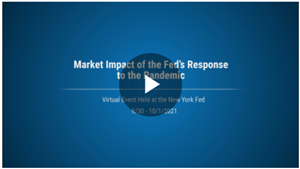Authors: Andrew F. Haughwout, Ben Hyman, and Or Shachar
-
- About the New York Fed
- What We Do
- Communities We Serve
-
More About Us
-
At the New York Fed, our mission is to make the U.S. economy stronger and the financial system more stable for all segments of society. We do this by executing monetary policy, providing financial services, supervising banks and conducting research and providing expertise on issues that impact the nation and communities we serve.

The New York Innovation Center bridges the worlds of finance, technology, and innovation and generates insights into high-value central bank-related opportunities.

Do you have a request for information and records? Learn how to submit it.

Learn about the history of the New York Fed and central banking in the United States through articles, speeches, photos and video.
-
- Markets & Policy Implementation
-
- Reference Rates
- Effective Federal Funds Rate
- Overnight Bank Funding Rate
- Secured Overnight Financing Rate
- SOFR Averages & Index
- Broad General Collateral Rate
- Tri-Party General Collateral Rate
- Desk Operations
- Treasury Securities
- Agency Mortgage-Backed Securities
- Repos
- Reverse Repos
- Securities Lending
- Central Bank Liquidity Swaps
- System Open Market Account Holdings
- Primary Dealer Statistics
- Historical Transaction Data
-
- Monetary Policy Implementation
- Treasury Securities
- Agency Mortgage-Backed Securities
- Agency Commercial Mortgage-Backed Securities
- Agency Debt Securities
- Repos & Reverse Repos
- Securities Lending
- Discount Window
- Treasury Debt Auctions & Buybacks
as Fiscal Agent - INTERNATIONAL MARKET OPERATIONS
- Foreign Exchange
- Foreign Reserves Management
- Central Bank Swap Arrangements
- ACROSS MARKETS
-
- Economic Research
- U.S. Economy
- Consumer Expectations & Behavior
- Growth & Inflation
- Economic Heterogeneity Indicators (EHIs)
- Multivariate Core Trend Inflation
- New York Fed DSGE Model
- New York Fed Staff Nowcast
- R-star: Natural Rate of Interest
- Labor Market
- Financial Stability
- Corporate Bond Market Distress Index
- Losses from Natural Disasters
- Outlook-at-Risk
- Treasury Term Premia
- Yield Curve as a Leading Indicator
- Banking
- RESEARCHERS
-
- Financial Institution Supervision
- Bank Applications
-
As part of our core mission, we supervise and regulate financial institutions in the Second District. Our primary objective is to maintain a safe and competitive U.S. and global banking system.

The Governance & Culture Reform hub is designed to foster discussion about corporate governance and the reform of culture and behavior in the financial services industry.

Need to file a report with the New York Fed? Here are all of the forms, instructions and other information related to regulatory and statistical reporting in one spot.

The New York Fed works to protect consumers as well as provides information and resources on how to avoid and report specific scams.
-
- Financial Services & Infrastructure
-
The Federal Reserve Bank of New York works to promote sound and well-functioning financial systems and markets through its provision of industry and payment services, advancement of infrastructure reform in key markets and training and educational support to international institutions.

The New York Innovation Center bridges the worlds of finance, technology, and innovation and generates insights into high-value central bank-related opportunities.

The growing role of nonbank financial institutions, or NBFIs, in U.S. financial markets is a transformational trend with implications for monetary policy and financial stability.

The New York Fed offers the Central Banking Seminar and several specialized courses for central bankers and financial supervisors.
-
- Community Development & Education
-
- Staff
-
Fed System Initiatives
- Other Community Development Work
- Calendar
-
September 2021
JEL classification: G14, G18, H74
At the onset of the COVID-19 pandemic, state and local governments were among the sectors expected to experience the most severe distress. The combination of a sharply deteriorating revenue picture, a pressing need for additional expenditures, delays in the receipt of substantial taxes owed, and an inability to access the financial markets raised serious concerns among many observers about the ability of state and local governments to meet their public service delivery responsibilities. In April 2020, the Federal Reserve announced the establishment of the Municipal Liquidity Facility (MLF) to help municipalities manage the cash flow challenges that the pandemic produced. The MLF ultimately offered three-year loans at penalty rates to a set of eligible municipal issuers that included states, large cities and counties, and a number of revenue bond issuers. Research suggests that the MLF, in spite of lending to only the State of Illinois and the Metropolitan Transportation Authority, contributed to a healing in the municipal securities market as a whole. Effects on real economic outcomes like employment in the sector are harder to attribute to facility
This paper was prepared for an upcoming issue of the Economic Policy Review and a related New York Fed conference, “Implications of Federal Reserve Actions in Response to the COVID-19 Pandemic.”
Ben Hyman declares that he has no relevant or material financial interests that relate to the research described in this paper. Prior to circulation, this paper was reviewed in accordance with the Federal Reserve Bank of New York review policy, available at https://www.newyorkfed.org/research/staff_reports/index.html.
Or Shachar declares that she has no relevant or material financial interests that relate to the research described in this paper. Prior to circulation, this paper was reviewed in accordance with the Federal Reserve Bank of New York review policy, available at https://www.newyorkfed.org/research/staff_reports/index.html.



